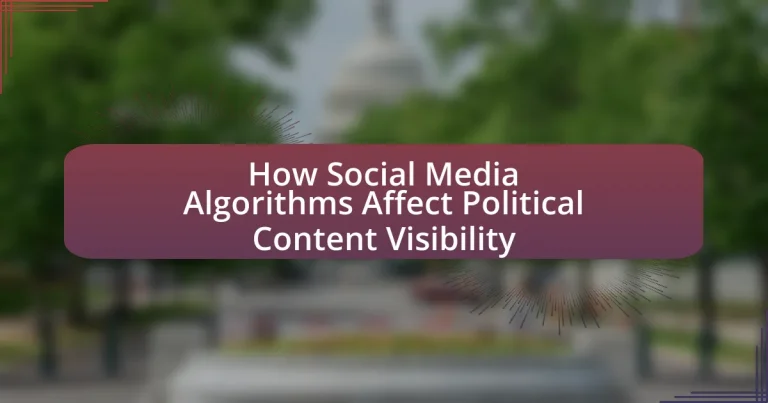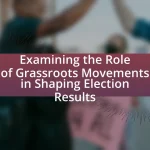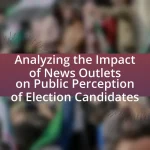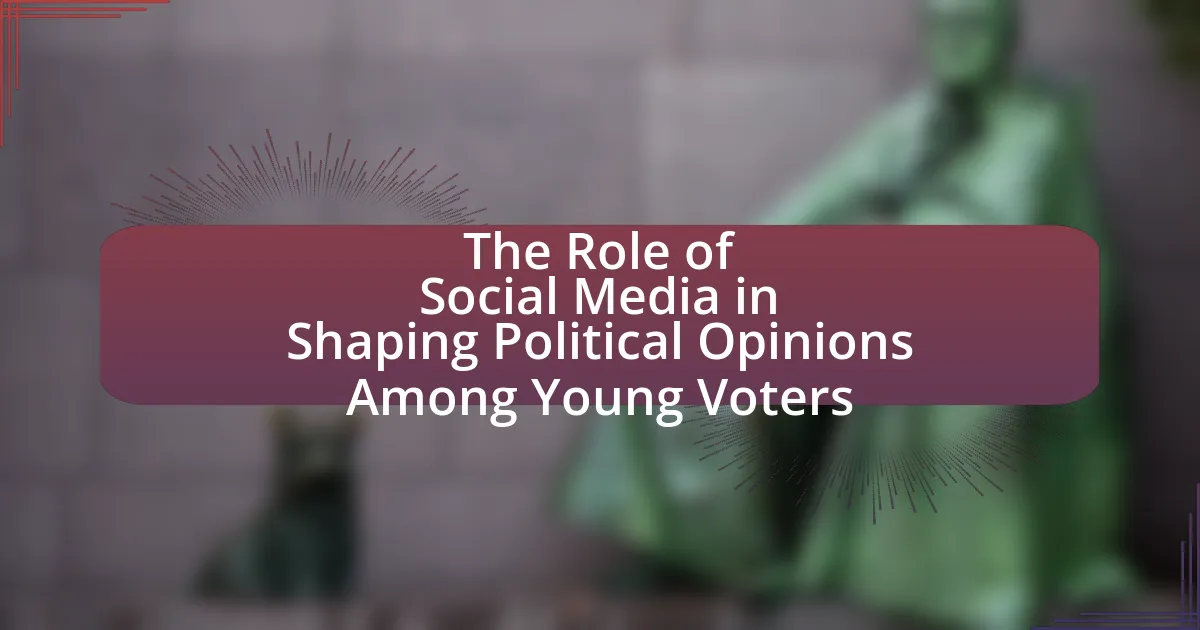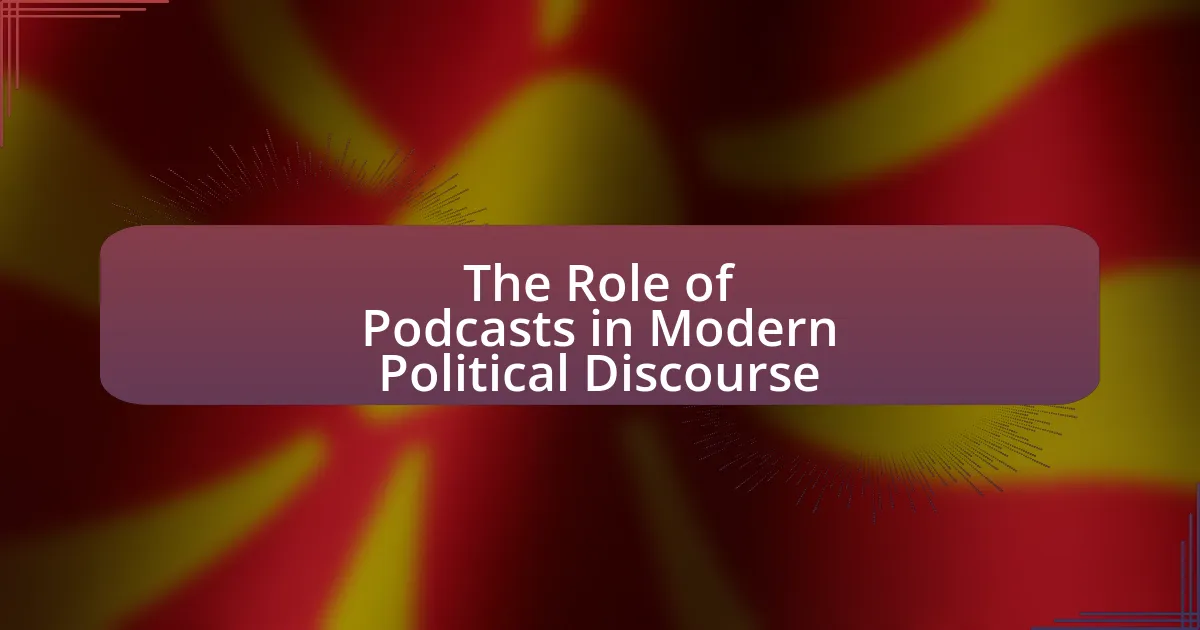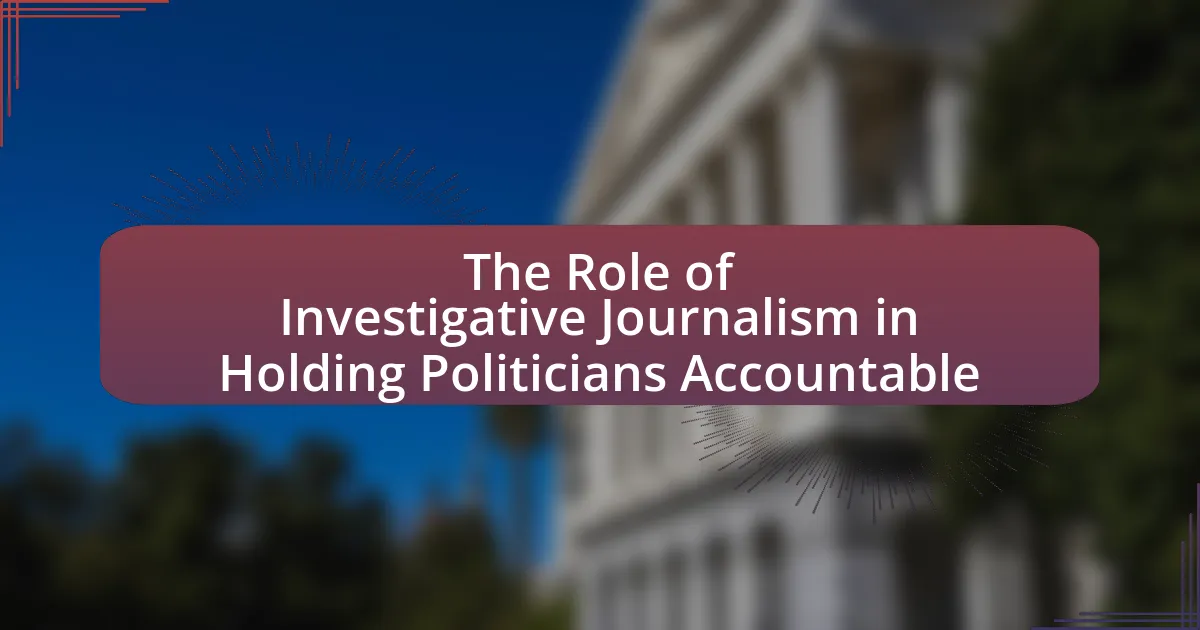Social media algorithms play a crucial role in determining the visibility of political content by prioritizing posts based on user engagement metrics such as likes, shares, and comments. These algorithms create echo chambers by repeatedly exposing users to similar viewpoints, which can shape public opinion and political discourse. The article explores how algorithms function, the key factors influencing content ranking, and the implications of algorithmic bias on political representation. It also discusses strategies for enhancing political content visibility and the importance of transparency and engagement in fostering informed civic participation.
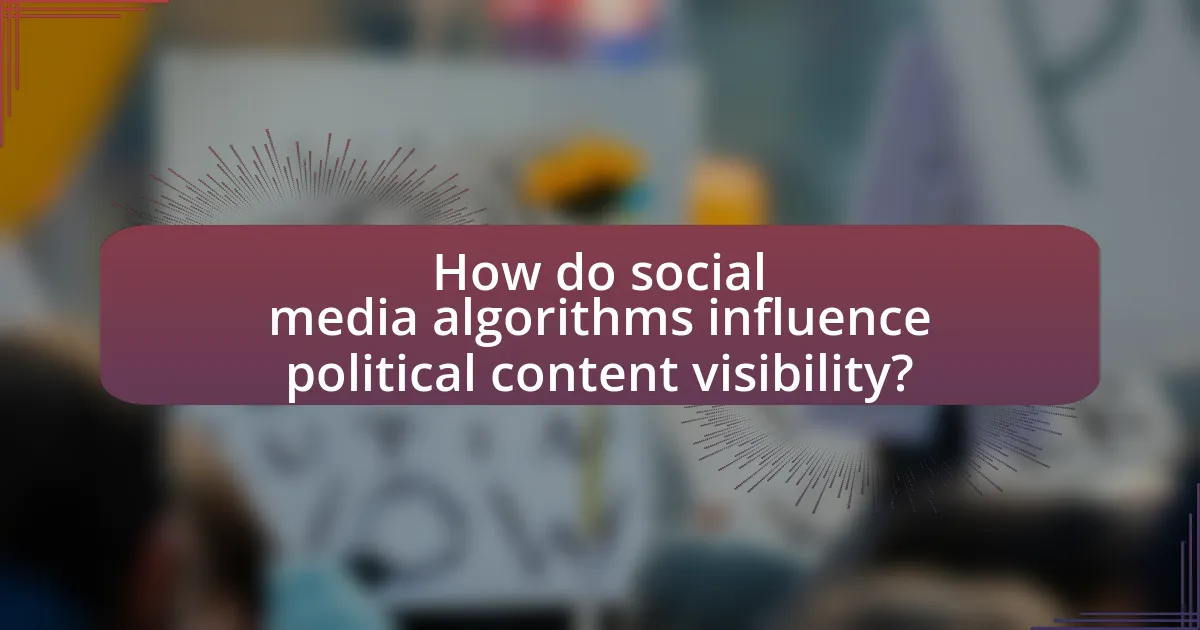
How do social media algorithms influence political content visibility?
Social media algorithms significantly influence political content visibility by prioritizing posts based on user engagement metrics such as likes, shares, and comments. These algorithms analyze user behavior to determine which content is most relevant and engaging, often amplifying sensational or polarizing political messages that generate higher interaction rates. For instance, a study by the Pew Research Center found that 64% of Americans believe social media platforms have a significant impact on the political landscape, as algorithms can create echo chambers by repeatedly exposing users to similar viewpoints. This selective exposure can shape public opinion and political discourse by limiting the diversity of information users encounter.
What are social media algorithms and how do they function?
Social media algorithms are complex mathematical formulas used by platforms to determine which content is shown to users based on various factors. These algorithms analyze user behavior, such as likes, shares, comments, and time spent on posts, to prioritize content that is most likely to engage the user. For example, Facebook’s algorithm uses machine learning to assess the relevance of posts by considering user interactions and the popularity of content among similar users, thereby influencing the visibility of political content based on its engagement metrics. This functionality directly impacts how political messages are disseminated and perceived, as higher engagement can lead to increased visibility, shaping public discourse and opinion.
What key factors do social media algorithms consider when ranking content?
Social media algorithms consider several key factors when ranking content, including user engagement, relevance, and recency. User engagement metrics such as likes, shares, comments, and time spent on posts indicate how well content resonates with audiences. Relevance is determined by the alignment of content with users’ interests and past behaviors, often assessed through data analytics. Recency ensures that newer content is prioritized, reflecting the dynamic nature of social media interactions. These factors collectively influence the visibility of content, particularly in the context of political discussions, where engagement can significantly impact the dissemination of information.
How do user interactions shape algorithmic decisions?
User interactions significantly shape algorithmic decisions by influencing the content that algorithms prioritize and recommend. When users engage with specific posts through likes, shares, or comments, algorithms analyze this data to determine which types of content are most appealing to audiences. For instance, a study by the Pew Research Center found that social media platforms often amplify content that generates high engagement, leading to increased visibility for posts that resonate with users. This feedback loop means that the more users interact with certain political content, the more likely similar content will be promoted, ultimately affecting the visibility of diverse political perspectives on social media.
Why is political content visibility important in social media?
Political content visibility is crucial in social media because it directly influences public opinion and democratic engagement. When political content is visible, it allows users to access diverse viewpoints, fostering informed discussions and participation in civic activities. Research indicates that increased visibility of political content can lead to higher voter turnout; for instance, a study by the Pew Research Center found that 69% of social media users reported that these platforms helped them stay informed about political issues. This visibility also enables marginalized voices to be heard, contributing to a more equitable political discourse.
How does visibility impact political discourse and engagement?
Visibility significantly impacts political discourse and engagement by determining which political content is seen and shared by users. Social media algorithms prioritize certain posts based on user interactions, leading to a selective exposure to political viewpoints. For instance, research by the Pew Research Center indicates that 64% of Americans believe social media has a mostly positive effect on their ability to engage with political issues, yet the same algorithms can create echo chambers that reinforce existing beliefs. This selective visibility can polarize opinions and limit exposure to diverse perspectives, ultimately shaping the nature of political discussions and civic participation.
What role does misinformation play in political content visibility?
Misinformation significantly increases the visibility of political content on social media platforms. Algorithms prioritize engagement, and misleading or sensational information often generates higher interaction rates, leading to greater exposure. For instance, a study by the Massachusetts Institute of Technology found that false news stories are 70% more likely to be retweeted than true stories, demonstrating how misinformation can dominate political discourse and visibility online. This dynamic creates an environment where misleading narratives can overshadow factual content, influencing public perception and political outcomes.
How do different platforms implement their algorithms for political content?
Different platforms implement their algorithms for political content by utilizing distinct methodologies tailored to their user engagement goals and content moderation policies. For instance, Facebook employs a combination of user engagement metrics, such as likes and shares, alongside fact-checking partnerships to prioritize content that aligns with community standards while attempting to reduce misinformation. Twitter, on the other hand, focuses on real-time engagement and trending topics, often amplifying tweets that generate significant interaction, which can lead to the rapid spread of political discourse. YouTube’s algorithm emphasizes watch time and viewer retention, promoting videos that keep users engaged, which can inadvertently favor sensational political content. These approaches reflect each platform’s strategy to balance user engagement with the responsibility of managing political discourse, as evidenced by their respective policies and algorithm updates aimed at addressing misinformation and harmful content.
What are the differences in algorithms between major social media platforms?
Major social media platforms utilize distinct algorithms that prioritize content differently, impacting political content visibility. For instance, Facebook’s algorithm emphasizes user engagement and interactions, promoting posts that generate comments and shares, which can amplify political content that resonates with users. In contrast, Twitter’s algorithm focuses on recency and relevance, showcasing tweets based on user interests and trending topics, which can lead to rapid dissemination of political messages during events. Instagram employs a visual-centric algorithm that prioritizes posts based on user interactions with similar content, potentially favoring visually appealing political campaigns. TikTok’s algorithm leverages machine learning to personalize content feeds based on user behavior, which can significantly influence the visibility of political content among younger audiences. These algorithmic differences shape how political messages are distributed and perceived across platforms, affecting user engagement and discourse.
How do these differences affect political content visibility across platforms?
Differences in social media algorithms significantly affect political content visibility across platforms by determining which posts are prioritized in users’ feeds. For instance, platforms like Facebook utilize engagement metrics, such as likes and shares, to amplify content that generates interaction, often leading to the visibility of sensational or polarizing political posts. In contrast, Twitter’s algorithm emphasizes recency and relevance, which can result in a different set of political content being highlighted, often favoring trending topics and real-time discussions. Research from the Pew Research Center indicates that algorithmic differences can lead to disparate exposure levels, with users on platforms like Instagram encountering more visually-driven political content, while those on Reddit may engage in more text-based discussions. These algorithmic variations thus create distinct environments for political discourse, influencing the reach and impact of political messages across different social media platforms.
What are the implications of algorithmic bias on political content?
Algorithmic bias significantly impacts political content by skewing the visibility and dissemination of information, which can influence public opinion and electoral outcomes. For instance, algorithms that prioritize sensational or polarizing content can amplify extreme political views while marginalizing moderate perspectives, leading to a distorted understanding of political issues among users. Research by the Pew Research Center indicates that 64% of Americans believe social media platforms have a significant impact on their political views, highlighting the power of algorithms in shaping political discourse. Furthermore, algorithmic bias can create echo chambers, where users are exposed primarily to content that aligns with their existing beliefs, reinforcing polarization and reducing exposure to diverse viewpoints.
How can algorithmic bias skew political representation?
Algorithmic bias can skew political representation by favoring certain political viewpoints over others, leading to unequal visibility of political content. This occurs when algorithms prioritize content that aligns with the preferences or behaviors of specific user demographics, often marginalizing alternative perspectives. For instance, a study by the Pew Research Center found that social media platforms can create echo chambers, where users are predominantly exposed to information that reinforces their existing beliefs, thus distorting the overall political discourse. This selective exposure can result in a misrepresentation of public opinion and diminish the diversity of political representation in online spaces.
What measures can be taken to mitigate algorithmic bias?
To mitigate algorithmic bias, organizations can implement diverse training data, conduct regular audits, and establish transparency in algorithmic processes. Diverse training data ensures that algorithms are exposed to a wide range of perspectives, reducing the risk of reinforcing existing biases. Regular audits, such as those recommended by the AI Now Institute, help identify and rectify biases in algorithms by analyzing their outputs across different demographic groups. Transparency in algorithmic processes, as advocated by the Partnership on AI, allows stakeholders to understand how decisions are made, fostering accountability and trust. These measures collectively contribute to a more equitable representation in algorithm-driven content visibility on social media platforms.
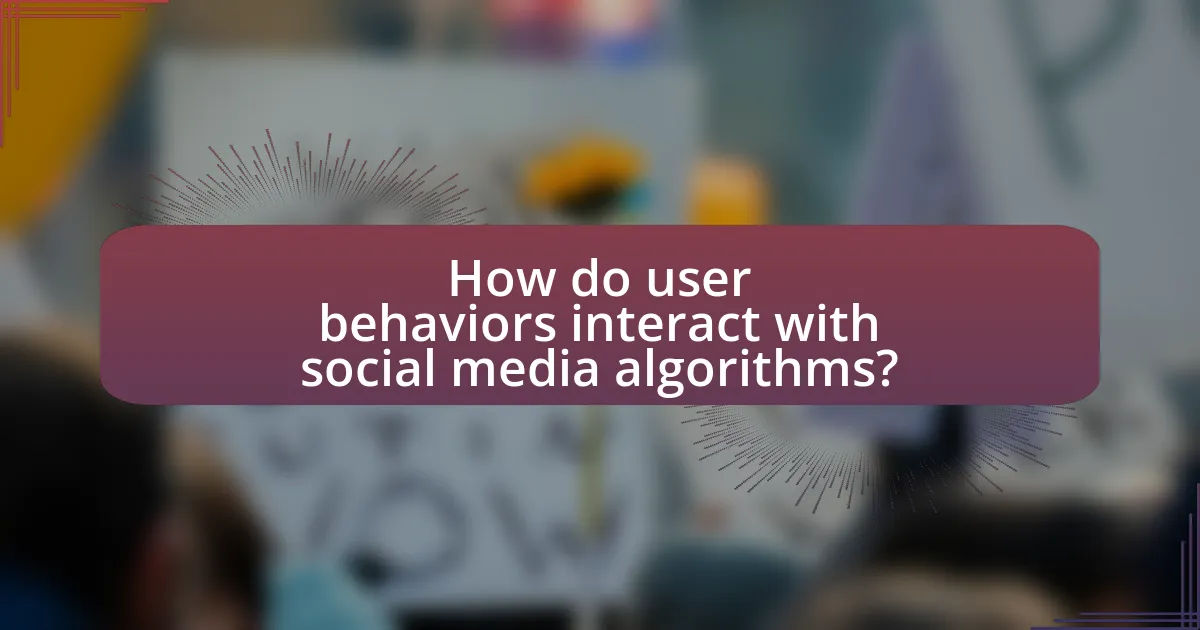
How do user behaviors interact with social media algorithms?
User behaviors significantly influence social media algorithms by determining the content that is prioritized and displayed to users. When users engage with specific types of content—such as liking, sharing, or commenting—algorithms take note of these interactions and adjust the visibility of similar content in the future. For instance, a study by the Pew Research Center found that users who frequently engage with political content are more likely to see similar posts in their feeds, as algorithms are designed to enhance user engagement by showing content that aligns with their interests. This feedback loop reinforces user preferences and can lead to echo chambers, where users are predominantly exposed to viewpoints that mirror their own, thereby affecting the overall visibility of diverse political content.
What types of user engagement are most influential on political content visibility?
User engagement types that are most influential on political content visibility include likes, shares, comments, and time spent on content. These engagement metrics directly impact how algorithms prioritize and distribute political content across social media platforms. For instance, a study by the Pew Research Center found that content with higher engagement rates, such as shares and comments, is more likely to be promoted by algorithms, leading to increased visibility. Additionally, research published in the Journal of Communication indicates that user interactions, particularly comments, can significantly enhance the reach of political posts, as they signal to algorithms that the content is relevant and engaging to users.
How do likes, shares, and comments affect algorithmic prioritization?
Likes, shares, and comments significantly influence algorithmic prioritization on social media platforms. These interactions serve as indicators of content relevance and user engagement, prompting algorithms to favor posts with higher engagement metrics. For instance, Facebook’s algorithm prioritizes content that generates more likes, shares, and comments, as this suggests that the content resonates with users, leading to increased visibility in users’ feeds. Research by the Pew Research Center indicates that posts with higher engagement are more likely to be seen by a larger audience, reinforcing the idea that social media algorithms are designed to promote content that garners user interaction.
What patterns of user behavior can lead to increased visibility of political content?
Increased visibility of political content is primarily driven by user engagement patterns such as liking, sharing, and commenting on posts. When users actively engage with political content, social media algorithms prioritize this content, leading to greater exposure. For instance, a study by the Pew Research Center found that posts with higher engagement rates are more likely to appear in users’ feeds, as algorithms favor content that generates interaction. Additionally, users who follow political pages or participate in discussions about political topics contribute to the algorithm’s recognition of their interest, further amplifying the visibility of related content.
How does echo chamber effect relate to social media algorithms?
The echo chamber effect is closely related to social media algorithms as these algorithms prioritize content that aligns with users’ existing beliefs and preferences, thereby reinforcing those beliefs. Social media platforms utilize algorithms that analyze user interactions, such as likes, shares, and comments, to curate a personalized feed that often excludes diverse viewpoints. Research indicates that this selective exposure can lead to increased polarization, as users are less likely to encounter opposing perspectives. For instance, a study by Bakshy et al. (2015) found that Facebook’s algorithm significantly influences the diversity of news articles users are exposed to, contributing to the echo chamber effect by limiting the range of information available to them.
What is the echo chamber effect and how does it manifest on social media?
The echo chamber effect is a phenomenon where individuals are exposed primarily to information that reinforces their existing beliefs, leading to a distorted perception of reality. This effect manifests on social media through algorithms that prioritize content similar to what users have previously engaged with, creating a feedback loop that limits exposure to diverse viewpoints. Research indicates that social media platforms, such as Facebook and Twitter, utilize algorithms that favor engagement, which often results in the amplification of polarizing content and the isolation of users within their ideological bubbles. A study by Bakshy et al. (2015) found that Facebook’s algorithm can significantly influence the diversity of news articles users are exposed to, thereby contributing to the echo chamber effect.
How do algorithms contribute to the formation of echo chambers?
Algorithms contribute to the formation of echo chambers by prioritizing content that aligns with users’ existing beliefs and preferences. Social media platforms utilize algorithms that analyze user behavior, such as likes, shares, and comments, to curate personalized feeds. This personalization often leads to the amplification of similar viewpoints while minimizing exposure to diverse perspectives. Research by the Pew Research Center indicates that 62% of social media users encounter content that reinforces their beliefs, which further entrenches these echo chambers. Consequently, algorithms create environments where users are less likely to engage with opposing viewpoints, fostering polarization and limiting constructive discourse.
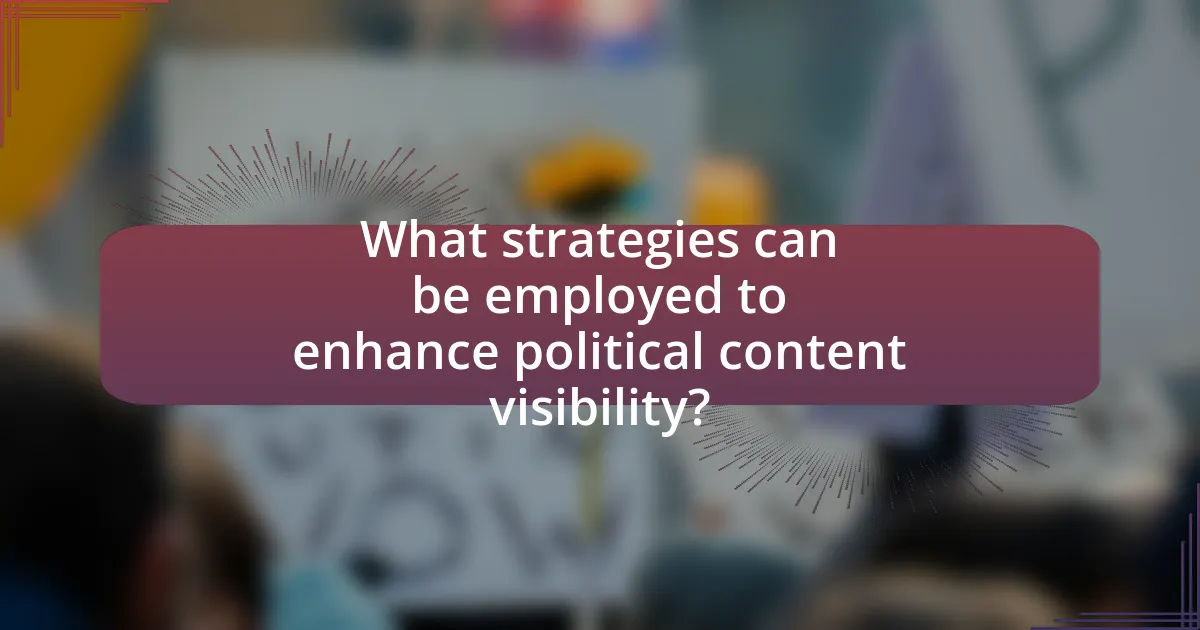
What strategies can be employed to enhance political content visibility?
To enhance political content visibility, employing targeted social media strategies is essential. Utilizing data analytics to identify audience demographics allows for tailored content that resonates with specific groups, increasing engagement. Additionally, optimizing content for search engines through relevant keywords and hashtags can improve discoverability. Research indicates that posts with visual elements, such as images or videos, receive 94% more views than text-only posts, further emphasizing the importance of multimedia in capturing attention. Engaging with followers through comments and shares fosters community interaction, which algorithms favor, thereby boosting visibility.
How can content creators optimize their posts for better visibility?
Content creators can optimize their posts for better visibility by utilizing relevant keywords, engaging visuals, and strategic posting times. Incorporating keywords that align with trending topics enhances searchability, as algorithms prioritize content that matches user queries. Engaging visuals, such as images and videos, increase user interaction, which is a key factor in algorithmic ranking. Additionally, posting during peak user activity times maximizes reach, as studies show that content shared when audiences are most active receives higher engagement rates. For instance, research indicates that posts made on weekdays between 10 AM and 3 PM tend to perform better in terms of visibility and engagement.
What types of content are favored by social media algorithms?
Social media algorithms favor content that generates high engagement, such as likes, shares, and comments. This includes visually appealing posts like images and videos, as well as content that prompts discussions or reactions, such as polls and questions. Research indicates that posts with emotional resonance, particularly those that evoke strong feelings like joy or anger, are prioritized in users’ feeds, enhancing visibility. For instance, a study by the Pew Research Center found that emotionally charged content is more likely to be shared, thus receiving greater algorithmic promotion.
How can timing and frequency of posts influence visibility?
Timing and frequency of posts significantly influence visibility by determining when and how often content appears in users’ feeds. Social media algorithms prioritize content based on user engagement, which is often highest during specific times of the day or week. For instance, studies show that posts made during peak hours, such as evenings or weekends, receive more interactions, leading to increased visibility. Additionally, consistent posting frequency can enhance algorithmic favorability, as platforms tend to promote accounts that regularly engage their audience. Research indicates that brands posting at least once a day can achieve 50% higher engagement rates compared to those posting less frequently. Thus, strategic timing and frequency are crucial for maximizing content visibility on social media platforms.
What best practices should political organizations follow on social media?
Political organizations should prioritize transparency, engagement, and data-driven strategies on social media. Transparency involves clearly communicating the organization’s goals, funding sources, and affiliations to build trust with the audience. Engagement requires actively responding to followers, addressing concerns, and fostering discussions to create a sense of community. Data-driven strategies include analyzing audience insights and social media metrics to tailor content that resonates with target demographics, thereby enhancing visibility. For instance, a study by the Pew Research Center found that organizations that engage with their audience through comments and shares see a significant increase in reach and influence.
How can political campaigns effectively engage with their audience?
Political campaigns can effectively engage with their audience by leveraging targeted social media strategies that align with audience interests and behaviors. Utilizing data analytics, campaigns can identify key demographics and tailor content to resonate with specific groups, enhancing engagement rates. For instance, a study by the Pew Research Center found that 69% of adults in the U.S. use social media, making it a crucial platform for reaching voters. Additionally, campaigns can employ interactive content, such as polls and live Q&A sessions, to foster direct communication and feedback, further solidifying audience connection.
What role does transparency play in enhancing political content visibility?
Transparency significantly enhances political content visibility by fostering trust and engagement among users. When political entities openly share their intentions, funding sources, and data usage, they create an environment where users feel more informed and empowered to engage with the content. Research indicates that transparency in political communication can lead to increased user interaction, as individuals are more likely to share and discuss content they perceive as credible and trustworthy. For instance, a study by the Pew Research Center found that 64% of social media users believe that transparency about the sources of information improves their ability to discern credible content. This trust ultimately drives higher visibility for political messages within social media algorithms, which prioritize content that generates user engagement.
What tools and analytics can help measure political content visibility?
Tools and analytics that can help measure political content visibility include social media analytics platforms, web analytics tools, and sentiment analysis software. Social media analytics platforms like Hootsuite and Sprout Social provide insights into engagement metrics, reach, and audience demographics, allowing users to assess how political content is performing across different channels. Web analytics tools such as Google Analytics track website traffic and user behavior, offering data on how visitors interact with political content online. Sentiment analysis software, like Brandwatch, analyzes public sentiment towards political topics, providing qualitative insights into how content is perceived. These tools collectively enable a comprehensive understanding of political content visibility and its impact on audiences.
How can analytics inform content strategy for political messaging?
Analytics can inform content strategy for political messaging by providing insights into audience behavior, preferences, and engagement patterns. By analyzing data from social media platforms, political campaigns can identify which messages resonate most with specific demographics, allowing for targeted content creation. For instance, a study by Pew Research Center found that 69% of adults in the U.S. use social media, making it a crucial channel for political communication. Furthermore, analytics can reveal the optimal times for posting content to maximize visibility and engagement, as well as the types of content (videos, images, text) that generate the most interaction. This data-driven approach enables campaigns to refine their messaging and improve overall effectiveness in reaching and influencing voters.
What metrics are most important for assessing visibility and engagement?
The most important metrics for assessing visibility and engagement are reach, impressions, engagement rate, and click-through rate. Reach measures the total number of unique users who see content, while impressions indicate how many times content is displayed, regardless of clicks. Engagement rate, calculated by dividing total interactions (likes, shares, comments) by total followers or reach, reflects how well content resonates with the audience. Click-through rate, the percentage of users who click on a link compared to the total number of users who view the content, indicates the effectiveness of calls to action. These metrics provide a comprehensive view of how content performs in terms of visibility and user interaction, essential for understanding the impact of social media algorithms on political content visibility.
